*This post may contain affiliate links. Read more »
This Turkish Şakşuka recipe is a explosion of colors, flavors, and textures. Imagine the juiciest eggplants, fried until golden and creamy, their velvety flesh bursting with buttery, smoky goodness. Plump tomatoes burst with natural sweetness, their vibrant red hues hinting at the irresistible feast that awaits. This recipe is easy, does't take long to make, and your family will love it!
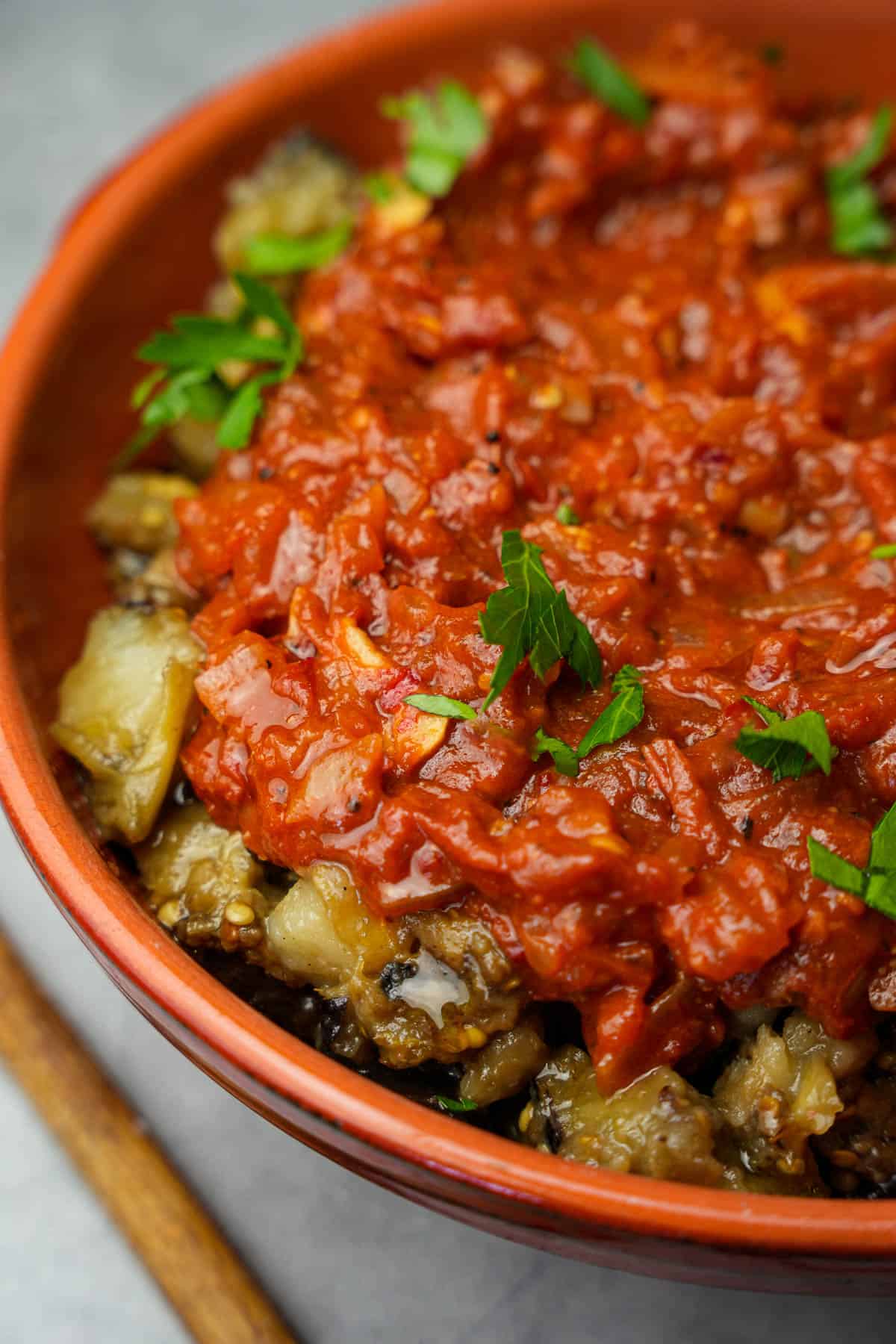

Enter your email & I'll send it to your inbox. Plus, get great new recipes from me every week!
By submitting this form, you consent to receive emails from Cinnamon Snail.
This Şakşuka recipe is not only an absolute pleasure to eat, but it is also healthy and accessible to everyone. It just so happens to be completely free from animal products, and gluten is nowhere to be found. Do you love the heck out of veggies, and hate gluten so much you scream at fields of wheat everywhere? Then this dish will make you play a gosh darn trumpet while you go off a ramp on rollerblades right into the ocean. (That’s like, a good thing, ok?)
This dish makes an unbelievable mezze to serve alongside bulgur pilavi, cig kofte, Turkish ezme salad and spicy marinated cucumbers.
So, get on your cutest-looking apron, gather your freshest ingredients, and get ready to create a feast that will transport you to the sun-kissed paradise of Turkey.
Jump to:
- 🥰Why you'll adore this Turkish saksuka recipe
- 🍆 Saksuka ingredients
- 🤯Are you a muscle man or some kind of protein freak?
- 📖How to make this Turkish shakshuka recipe
- 📍How Turkish shakshuka came to dominate the Mediterranean culinary landscape.
- 💡Serving Ideas
- 🤷♀️FAQ
- ✌️My faves to serve with this Turkish shakshuka recipe:
- Şakşuka (Turkish eggplant shakshuka recipe)
🥰Why you'll adore this Turkish saksuka recipe
🙌 Gluten-free goodness gracious: Face it, you or someone you know hates gluten so much you just want to punch gluten in the face. But now you don’t have to. You can just eat this instead, and that’s a much more peaceful way of dealing with your gluten intolerance…
🙅♀️ This vegan dish isn’t lame: I love food that “just happens” to be vegan. There is no fake meat, or hard-to-find ingredients. Nothing that is gonna make your carnivore friends look at you weirdly when you share this dish with them. That’s why as a caterer, I serve Shakshuka at vegan weddings and other events where there are going to be tons of non-veg eaters. Like all of the vegan Turkish recipes on this site, everyone loves it!
Easy peasy, lemon squeezy: Cooking doesn't have to be rocket science, my darlings. This recipe is as easy as pie (and yes, you can have pie for dessert if you want). Just a few simple steps and a handful of ingredients, and you'll have a dish that looks like it's been crafted by a culinary wizard who lives in tree or whatever.
✅ Tested and Approved Worldwide: Like all of the vegan recipes I share, after I tweaked and perfected the living daylights out of this saksuka recipe, I had it checked by a massive team of recipe testers from all around the world. It's confirmed: you will love it, pretty much no matter where you live on Earth.


Transform Your cooking with Turkish Vegan Magic
This 6-day program is 100% FREE. Get Ready to Master Turkish Vegan Cuisine!
🍆 Saksuka ingredients
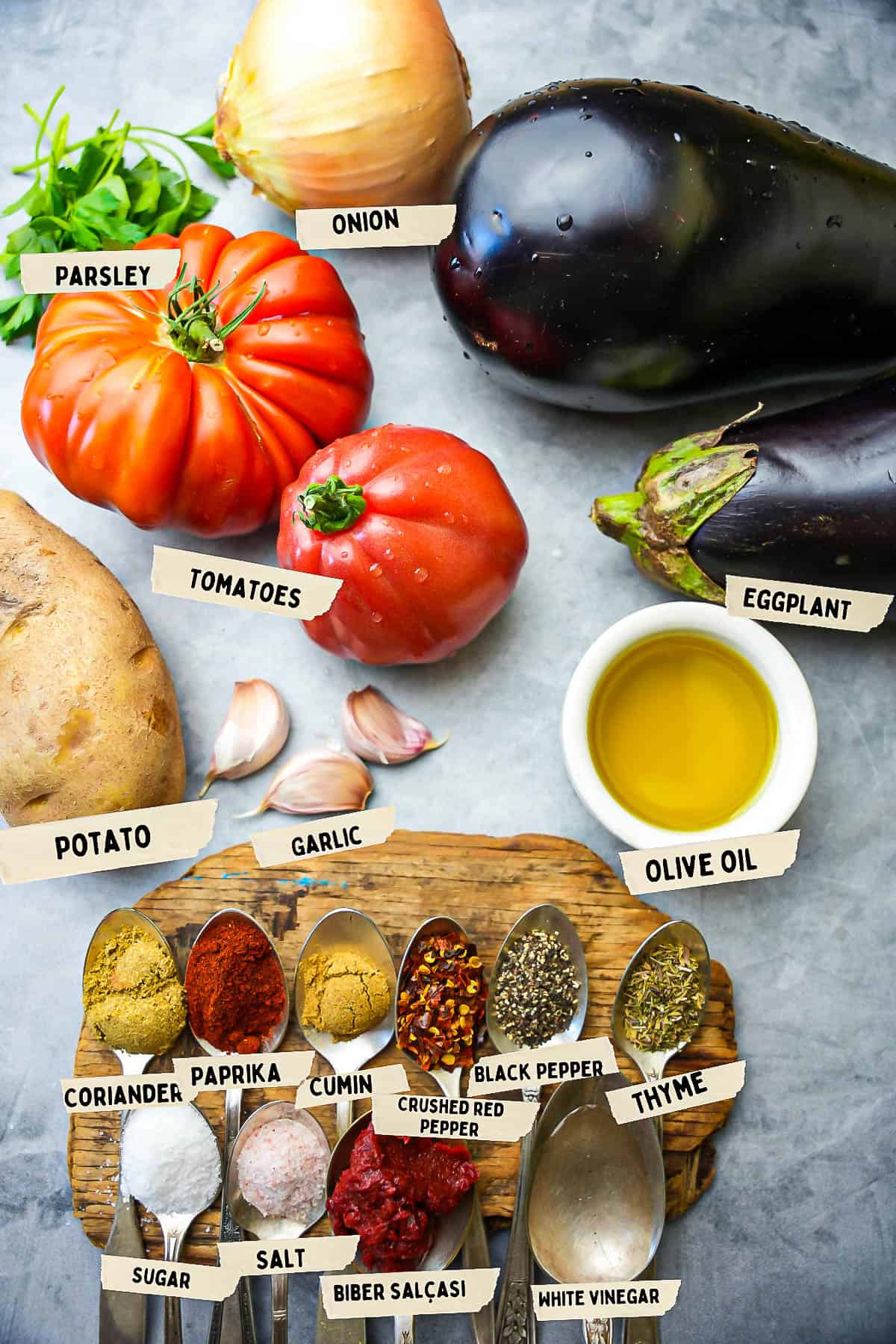
🍆Eggplant (Patlıcan)
Regular purple eggplants are what I use for making şakşuka (zaalouk and borani banjan too for that matter). Its rich and creamy flesh adds a delightful smoky flavor to the dish. Smaller eggplant varieties, like the Indian eggplants you would use to make makdous, have too high of a skin to meat ratio to give you good bang for your buck here.
🌶️Tatlı Biber Salçası
This mild Turkish red pepper paste brings a burst of vibrant flavor and a touch of sweetness to Shakshuka. It's made from sun-dried red peppers and adds a unique depth to the dish. If you like spicier food, you can use "Acı Biber Salçası” instead. It is a fiery and flavorful paste made from hot red peppers. It adds a delicious kick to dishes.
If you can't find it, you can substitute it with a combination of tomato paste and a pinch of chili powder for a similar flavor profile. But if you love making Turkish food, you are going to want to pick this stuff up to have on hand. It's used in lots of Turkish dishes.
🏺Ground Coriander (Kişniş)
This aromatic spice adds a warm and citrusy note to Şakşuka. It complements the other ingredients beautifully, enhancing the overall flavor profile. If you don't have ground coriander on hand, you can try using ground cumin as a substitute, though the flavor will be slightly different.
🫒Extra Virgin Olive Oil (Sızma Zeytinyağı)
The liquid gold of the Mediterranean! Extra virgin olive oil brings a luxurious richness and fruity undertones to Şakşuka. Its smooth texture helps bind the flavors together and deliver the flavors by coating your tongue. If you can't get your hands on extra virgin olive oil, you can use any other high-quality vegetable oil, such as avocado oil or grapeseed oil, to achieve a similar, albeit less traditional result.
*See the recipe card at the bottom of the page for exact quantities, nutritional info, and detailed cooking directions.
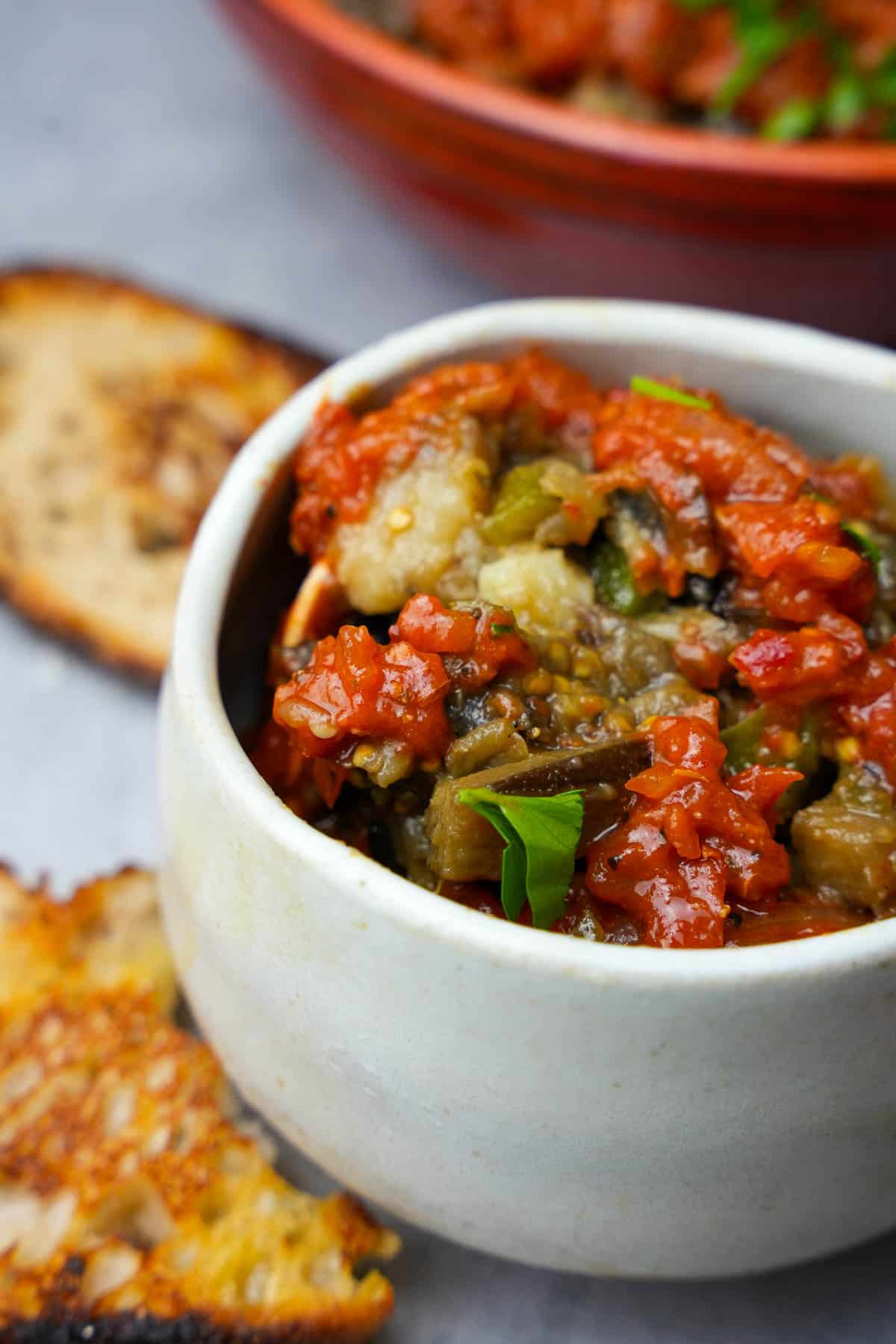
🤯Are you a muscle man or some kind of protein freak?
Don’t worry I still love you, I am just scared for my life… Here are a few variations of this versatile dish that you can use to add more protein to the dish:
💪Chickpea Şakşuka: Add a drained can of chickpeas to the veggies before you add the tomato sauce. Their nutty flavor and creamy texture complement the fried vegetables beautifully. You can either fry the chickpeas along with the eggplant or simply stir them in towards the end. Boost the protein by pairing saksuka with Turkish barbunya pilaki.
💪Mediterranean Tofu Şakşuka: For an extra dose of protein, add hand-torn bits of firm tofu. Fry the tofu until golden brown while you are frying the eggplant. It may add a couple more minutes of cooking time to that stage. The tofu will soak up the flavorful juices.
💪Spicy Lentil Şakşuka: Lentils are a fantastic plant-based protein source, and they work wonders in Şakşuka. Cook about a cup of brown lentils or split red lentils separately until tender. Drain them and then mix them with the fried vegetables and spices. The lentils will add delicious earthiness and heartiness to the dish. Or serve em' with a few mercimek köfte.
If you make one of these variations, you may want to adjust the salt or other seasonings to compensate for the extra unseasoned bulk you add to the dish. Leave me a comment on the recipe if you make one of these tweaks.
Or you can totally just serve this alongside Turkish ezogelin soup or Lebanese lentil soup, both of which are gosh darned protein powerhouses.
📖How to make this Turkish shakshuka recipe
You wanna see how this sensational Turkish mezze gets made? I will grab you by your gorgeous jewel-bedazzled glove and walk you through the whole process one step at a time. Or you can follow along with the easy-to-print recipe card towards the bottom of this page.
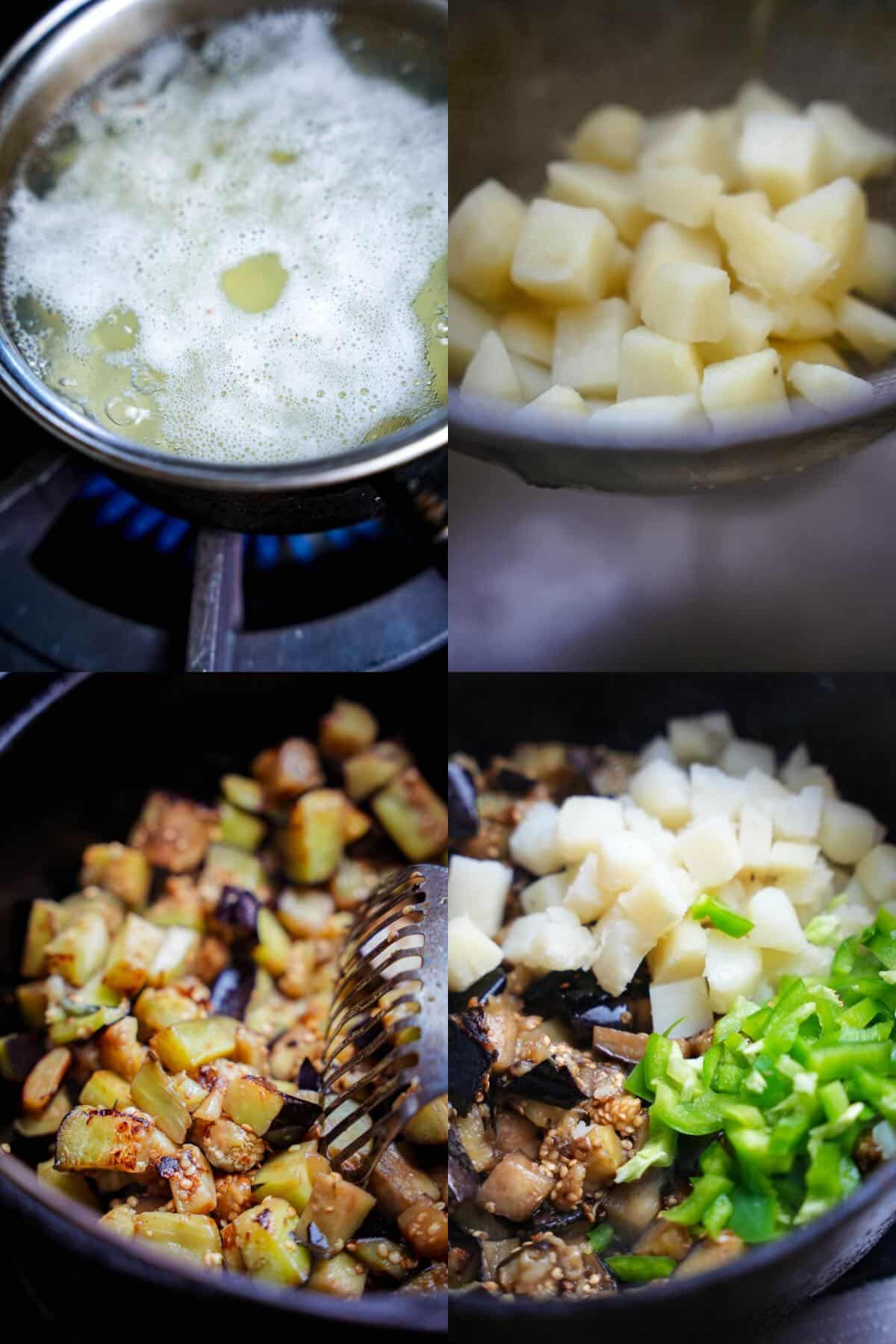
Step 1
Place the peeled and diced potatoes into a saucepan, ensuring they are fully submerged in water. Bring the pan to a boil over high heat. It's also totally fine to steam them instead of boil them, if that's your thing. Cook until the potatoes are fork-tender, then drain them using a colander. To check for doneness, pierce the potatoes with a fork (that’s why they are called “fork tender”) to ensure they are soft enough.
Step 2
Drain the cooked potatoes in a colander or mush strainer.
Step 3
Meanwhile, heat olive oil in a Dutch oven, large frying pan, or wok over high heat. Allow the oil to get hot for about 60 seconds. This ensures a nice sear and golden color on the eggplant.
Add the diced eggplant to the hot oil and stir regularly for approximately six minutes, or until the eggplant turns uniformly golden. Regular stirring prevents sticking and helps to distribute the heat evenly.
Step 4
Add the diced pepper, salt and the drained potatoes to the pan with the eggplant. Sauté the mixture for about three minutes, or until the peppers have softened. You can adjust the sautéing time based on your desired level of tenderness for the peppers.
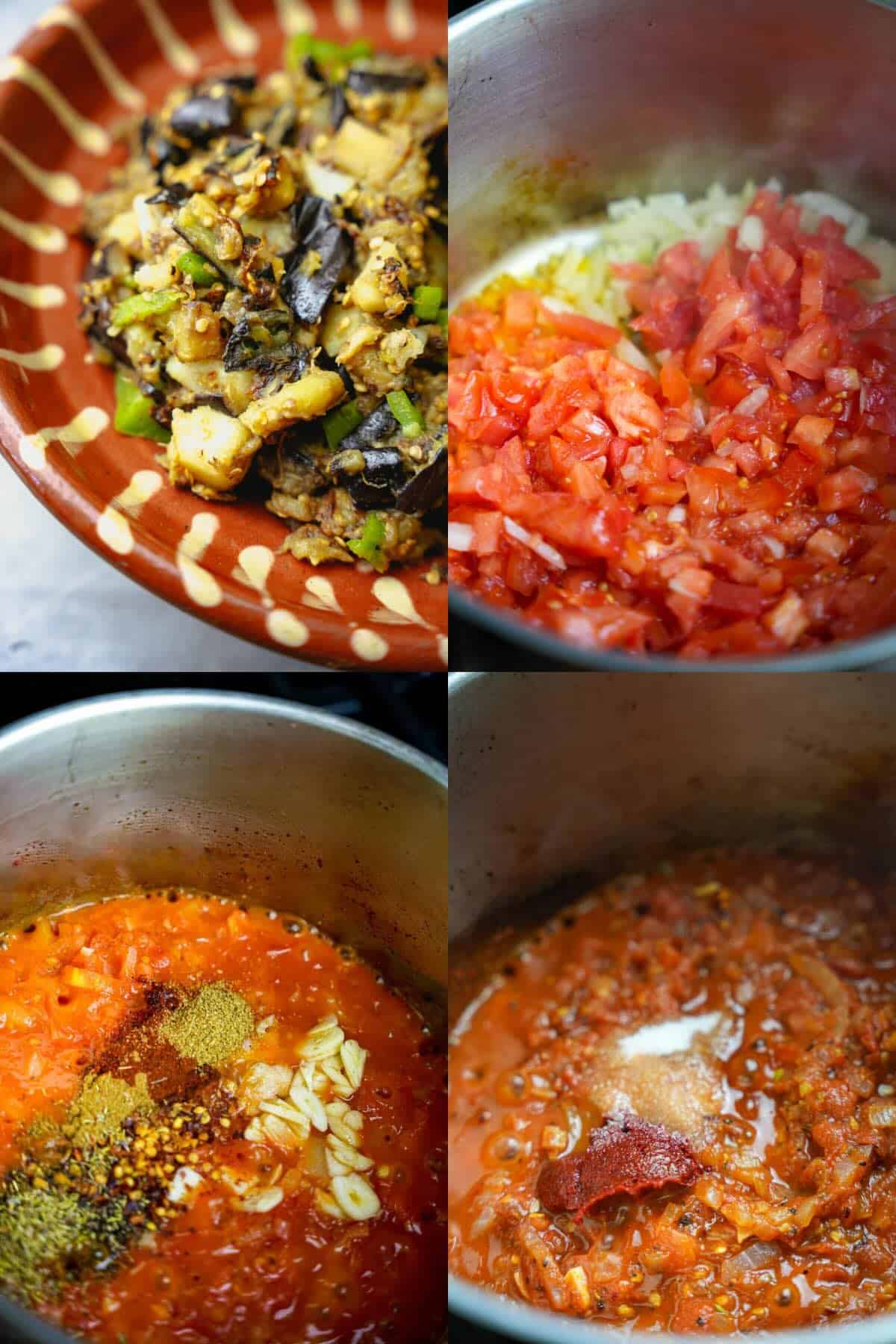
Step 5
Transfer the contents of the pan into an attractive serving bowl and set it aside while preparing the tomato sauce.
Step 6
Return the same pan to the stovetop over high heat. If the pan seems dry, add a tablespoon of extra olive oil. Add the diced tomato and onion to the hot pan and sauté for about three minutes, until the tomatoes begin to break down and release their juices, and the onion becomes fragrant. Cooking the onion and tomato together melds their flavors and gives them a rich taste.
Step 7
Stir in the garlic, paprika, ground coriander, cumin, red pepper flakes, thyme, and black pepper. Continue sautéing for another two minutes until the mixture becomes fragrant.
Step 8
Add the vinegar, sugar, pepper paste (or tomato paste), and salt to the pan. Adjust the heat to low and let the sauce simmer for approximately eight minutes, stirring occasionally, until it thickens and darkens. This simmering process allows the flavors to meld together and the sauce to develop a rich consistency.
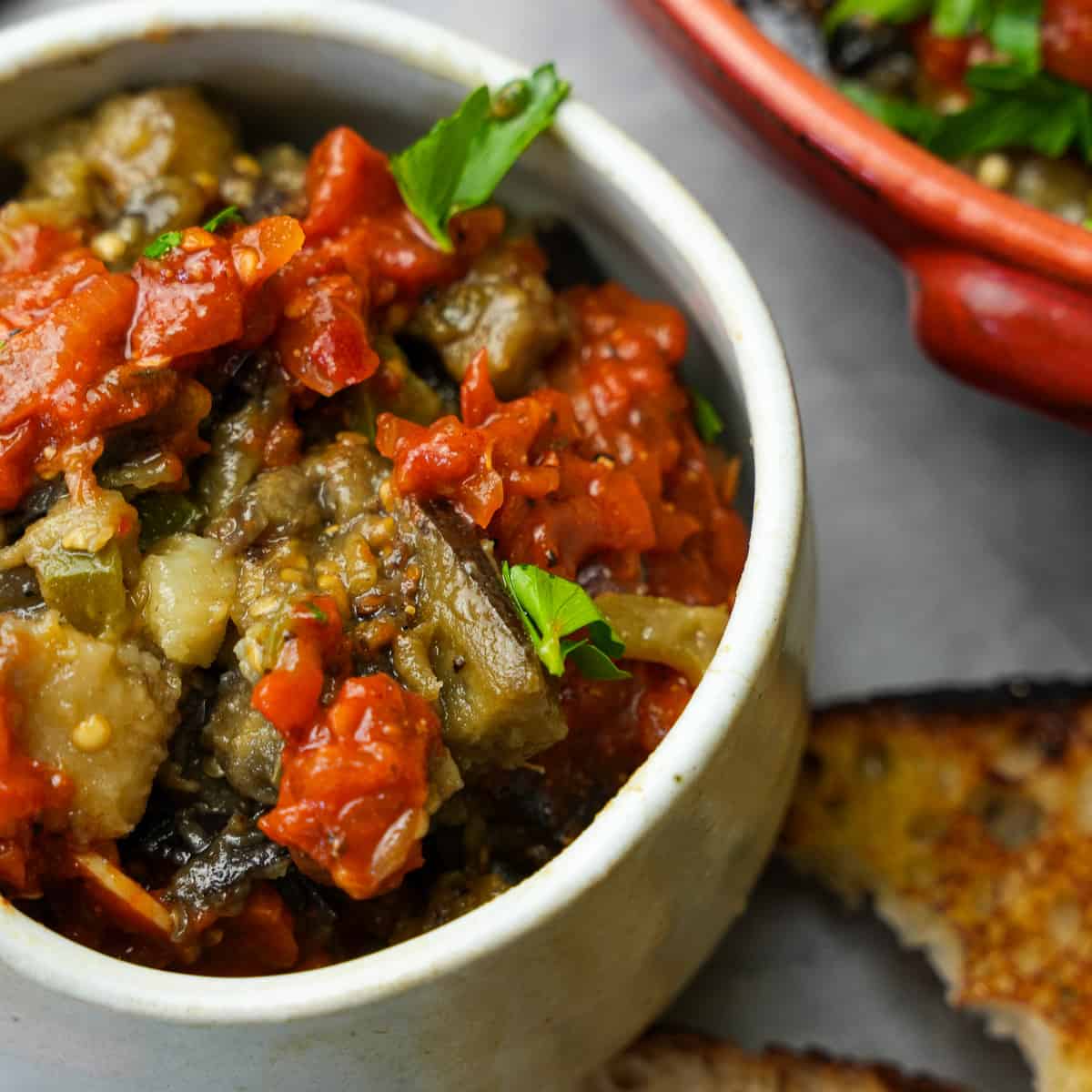
Step 9
Pour the tomato sauce over the eggplant, potatoes, and peppers in the serving bowl. Garnish with fresh parsley and minced onion.
📍How Turkish shakshuka came to dominate the Mediterranean culinary landscape.
Şakşuka shares resemblances with other dishes from the area, such as the Israeli dish "Shakshuka," which features eggs poached in a tomato and pepper sauce, and the Greek dish "Briam," a baked vegetable medley. These culinary similarities highlight the cross-pollination of flavors and cooking techniques across the Mediterranean.
Turkish cuisine, renowned for its diverse and flavorful dishes, has embraced Şakşuka as a popular meze, or appetizer. The dish holds a significant place in Turkish culinary traditions and is often enjoyed during family gatherings, festivals, and special occasions.
The Mediterranean region has been a hub of cultural exchange, trade, and migration throughout history. As different cultures and civilizations interacted, their culinary practices intertwined, creating dishes like Şakşuka. This culinary fusion reflects the rich tapestry of the region's history and the shared love for bold flavors and fresh ingredients.
💡Serving Ideas
Here are some accompaniments you can make to serve with this dish that are a real slam dunk:
Serve this creamy eggplant with çiğ köfte, or cucumber beet salad. I love putting a spoonful of fried eggplant on my oyster mushroom shawarma, seitan kofta served on freshly grilled whole wheat pita bread, dripping with tahini dressing and amba sauce as a sabich sandwich.
Gobble it up with some yalya corbasi, or Turkish olive oil braised celery root why don'tcha?
Finish off your meal with a sweet treat by serving Şakşuka with this perfect pistachio baklava. The delicate layers of pastry, filled with pistachios and drizzled with rosewater syrup, provide a delightful contrast to the savory flavors of the main dish.
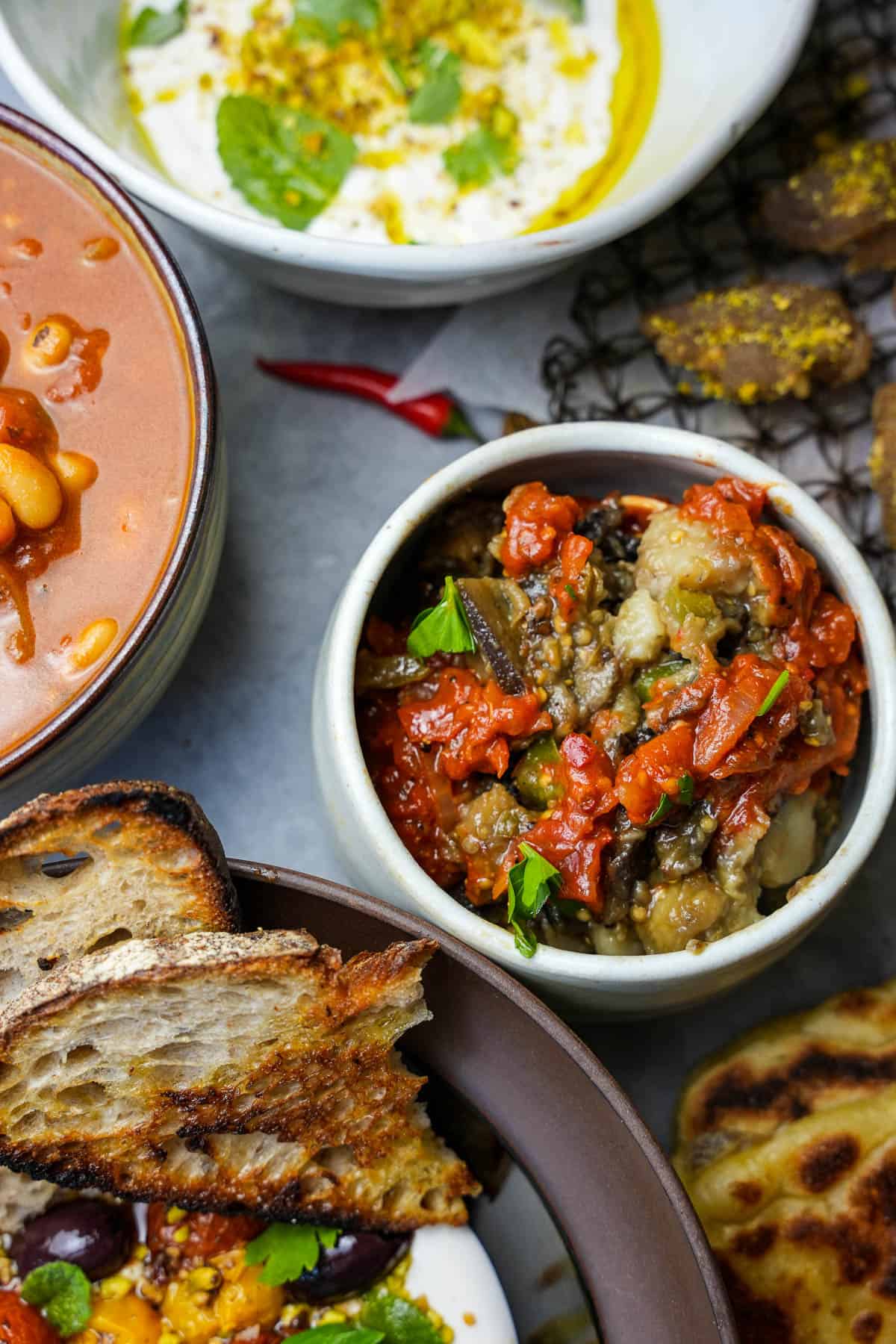
🤷♀️FAQ
The Turkish Şakşuka and the Israeli version, often referred to as Shakshuka, are both delicious and vibrant dishes, but they aren’t the same exact thing:
Base ingredients: In Turkish Şakşuka, the base typically consists of fried or roasted eggplants, tomatoes, peppers, and onions, often with a tomato sauce on top. On the other hand, Israeli Shakshuka focuses on a tomato-based sauce with poached eggs as the main protein (though you can also make vegan shakshuka with poached tofu eggs).
Spice profile: The spices used in each dish differ slightly. Turkish Şakşuka often incorporates spices like ground coriander, cumin, paprika, and Biber Salçası (Turkish pepper paste), for a warm and aromatic flavor. Israeli Shakshuka leans towards spices such as cumin, paprika, and sometimes harissa for a bolder and spicier taste.
Serving style:
While both dishes are typically enjoyed as a main course, the serving style can differ. Turkish Şakşuka is often served at room temperature or cold as a meze (appetizer) or a side dish alongside other Turkish dishes. Israeli Shakshuka is commonly served hot, straight from the pan, with the poached eggs nestled in the tomato sauce.
Regional variations: Both dishes have regional variations within their respective countries. For example, Turkish Şakşuka can vary in terms of ingredients and spice levels depending on the region. Similarly, Israeli Shakshuka may feature additions like feta cheese, bell peppers, or different herbs based on personal preference or regional variations.
Turkish cities like Istanbul, Izmir, Antalya, and Bodrum are known for their vibrant food scenes and are popular places to enjoy this flavorful dish. The seaside towns and cities along the Aegean and Mediterranean coasts offer an abundance of fresh produce, including eggplants and peppers, which are essential ingredients in Şakşuka. When this dish is made closest to where the produce is grown, it is fresher and more flavorful as the tomatoes, eggplants, peppers, and other ingredients have had a chance to ripen on the vine.
❄️Refrigeration:
Allow the Şakşuka to cool to room temperature for 30 minutes after cooking. I prefer to keep the sauce, and vegetables separate so that I can nicely plate the dish when I reheat them, but if you don't intend to reheat them, or don't care if the sauce gets mixed in during reheating, you can store them in one container. Shakshuka can be stored in the refrigerator for up to four days.
🔥Stovetop reheating:
Place the fried vegetables in a saucepan over medium heat. If needed, add a splash of water or vegetable broth to prevent sticking and help with reheating. Stir occasionally and heat until warmed through. Meanwhile, heat the tomato sauce in a separate saucepan over low heat. Once both the vegetables and sauce are heated, serve the vegetables on a plate or bowl, and pour the warm tomato sauce over them. Don't forget to add fresh garnishes for extra flavor!
☢️Microwave reheating:
Transfer the fried vegetables to a microwave-safe dish. Cover the dish with a microwave-safe lid or microwave-safe plastic wrap, leaving a small vent for steam to escape. Heat on medium power in one-minute increments, stirring in between, until heated thoroughly. Meanwhile, transfer the tomato sauce to a microwave-safe bowl and heat it separately. Once the vegetables and sauce are heated, combine them, adding the sauce to the vegetables. Add fresh garnishes as desired.
✌️My faves to serve with this Turkish shakshuka recipe:
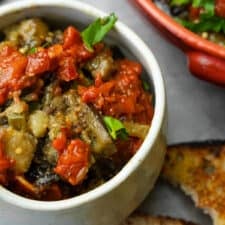
Şakşuka (Turkish eggplant shakshuka recipe)
Equipment
Ingredients
- 1 medium russet potato peeled and diced into 1 cm. cubes
- ⅓ cup olive oil
- 2.2 lbs. 1 kg. eggplant, diced into 1 cm. cubes
- ½ green bell pepper diced
- ½ teaspoon salt or to taste
- ½ medium yellow onion diced
- 2 large beefsteak tomatoes finely diced
- 3 cloves garlic peeled and sliced
- 1 teaspoon smoked paprika
- 1 teaspoon ground coriander
- ½ teaspoon toasted cumin seeds
- 1 teaspoon crushed red pepper flakes
- ½ teaspoon dried or fresh thyme
- ½ teaspoon ground black pepper
- 1 ½ teaspoons white vinegar
- 1 teaspoon sugar
- 2 teaspoons tatlı biber salçası Turkish pepper paste or tomato paste
- ¾ teaspoon salt
To garnish:
- 2 tablespoons minced fresh parsley
- 4 teaspoons finely minced red or yellow onion
Instructions
- Place the peeled diced potatoes into a saucepan with water to cover, and bring up to a boil over a high flame. Cook until fork tender and then drain in a colander.
- While the potato is cooking, heat the olive oil over a high flame in a wok, dutch oven, or large cast iron skillet over a high flame.
- After 60 seconds when the oil is hot, add the diced eggplant, and fry in the oil, stirring regularly for 6 minutes or until uniformly golden.
- Add the drained potatoes, pepper, and salt. Sauté for three minutes until the peppers are softened.
- Place the fried vegetables into an attractive serving bowl and set them aside while you prepare the tomato sauce in the same pan.
- Return the pan to the stovetop over high heat and add a tablespoon of extra olive oil if the pan is dry. Add the diced tomato and onion to the hot pan. Sauté for 3 minutes until the tomato starts to break down and the onion is fragrant.
- Stir in the garlic, paprika, coriander, cumin, red pepper flakes, thyme, and black pepper, and sautéed for another two minutes until fragrant.
- Add the vinegar, sugar, pepper paste (or tomato paste), and salt, adjust the heat to low, and simmer the sauce for 8 minutes, stirring occasionally until thick and dark.
- Place the tomato sauce over the eggplant, potatoes and peppers, and garnish with parsley and minced onion.
Notes

Enter your email & I'll send it to your inbox. Plus, get great new recipes from me every week!
By submitting this form, you consent to receive emails from Cinnamon Snail.



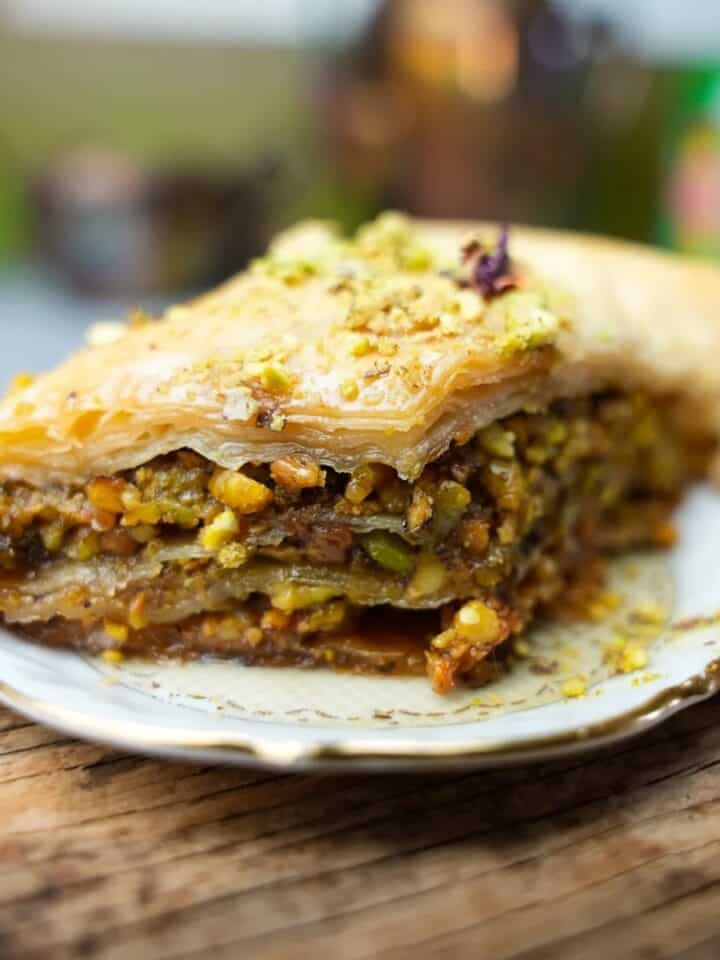







Terez says
This is a wonderful spicy vehicle for my garden eggplants and tomatoes! Can't wait to try it again when it has developed overnight. I did take longer than 30 minutes, but I always take much longer than the time estimates. One question: the recipe calls for toasted cumin seeds, but pics reflect ground cumin......
Jennifer says
This soup was delicious. So filling and flavorful. Aside from adding a little sumac and urfa chili, I followed the recipe exactly.
Cheryl says
Easy to follow and seems like a simple ingredient dish, but when put all together it is incredibly flavorful and goes wonderful scooped up with a piece of Msemen
Heva says
Cinnamon Snail is my go-to resource for vegan recipes. Not only are the recipes easy to make, they are always so flavorful and satisfying. The instructions are clear and easy to follow. This eggplant Şakşuka is amazing. I highly recommend Adam’s recipes for anyone looking for delicious vegan meals!